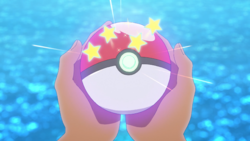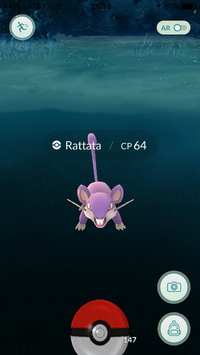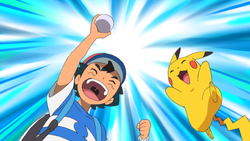Caught Pokémon: Difference between revisions
m (→Trivia) |
|||
| Line 227: | Line 227: | ||
*** the {{ball|Luxury}}'s description in FireRed and LeafGreen, | *** the {{ball|Luxury}}'s description in FireRed and LeafGreen, | ||
*** the program "Breaking News TV" on [[television]]s in {{game|Emerald}}, | *** the program "Breaking News TV" on [[television]]s in {{game|Emerald}}, | ||
*** | *** [[Krane Memo|Krane Memo 4]], [[Fateen]], and two other NPCs in {{XD}}, | ||
*** the [[nickname]] prompt in [[Generation III]], | *** the [[nickname]] prompt in [[Generation III]], | ||
*** [[Cyrus]], the Team Galactic Report, and another NPC in Diamond, Pearl, and Platinum, | *** [[Cyrus]], the Team Galactic Report, and another NPC in Diamond, Pearl, and Platinum, | ||
Revision as of 09:59, 29 April 2019
Caught Pokémon (Japanese: 捕まえたポケモン Caught Pokémon, mostly referred to as GETしたポケモン Got Pokémon by anime characters, using the English word get) are Pokémon that have been put in the control of a Pokémon Trainer by the use of a Poké Ball, or by trading with another Trainer.
The terms "catch" and "capture" are often used interchangeably in the games and in the anime. In the context of Pokémon Rangers, however, capture also has a separate meaning, referring to the technique a Pokémon Ranger uses to gain a Pokémon's assistance by befriending it, without controlling it as its Trainer.
Procedure

The catching process typically involves a battle in which the Pokémon is at first weakened and/or affected with a status condition, at which point the Trainer throws a Poké Ball (or upgraded version) at said Pokémon in order to catch it. Catching Pokémon is central to all canons in the Pokémon franchise; a caught Pokémon can be used in battling and for quests to aid Trainers, whereas Pokémon in the wild cannot, except in some episodes in the anime.
In the core series games, the success of a catch depends on catch rate. Pokémon that are caught do not need to obey their owners; if a Pokémon is traded and the Trainer does not have the Badge required, it may disobey and refuse to execute a move during battles. In the Pokémon anime, even with many Badges or being under original ownership, many Pokémon still may refuse to listen until trust is gained between the Trainer and Pokémon.
Caught Pokémon are stronger than Pokémon in the wild in the games. At the same level, a caught Pokémon will often have more points in their statistics than a wild one; this is due to the fact that caught Pokémon gain EVs from every battle they partake in, and therefore, on training, will gain points in their stats based on what they've encountered. This becomes more and more obvious at the later stages of the game, where the higher levels allow for a greater disparity of stats between caught and wild Pokémon, especially those raised from a low level, giving the Trainer a more decisive edge in wild battles.
Caught Pokémon can level up, learn new moves in battle, and evolve, while wild Pokémon cannot.
Newly caught Pokémon are no stronger or weaker than their wild counterparts, with the exception of innate IV differences. By using some varieties of Poké Ball, such as the Luxury Ball and Friend Ball, a Pokémon's friendship may be higher than usual upon being caught.
Wild Pokémon that are fused with other Pokémon cannot be caught, with prime examples being Kyurem in Black 2 and White 2 and Dusk Mane/Dawn Wings/Ultra Necrozma in Ultra Sun and Ultra Moon.
Pokémon GO

Pokémon GO introduced a different procedure in which the catching process involves accurately throwing a Poké Ball at a wild Pokémon without first weakening the Pokémon in battle. When pressing and holding down the Poké Ball, on the bottom of the screen, a colored target ring will appear in front of the wild Pokémon, constantly shrinking and immediately returning to its full size once it reaches the smallest size. The goal is to hit the Pokémon with a Poké Ball inside the target ring, when it is as small as possible, by flicking the ball towards the Pokémon. The smaller the ring when hit, the better the capture rate and the more XP is gained. Players can further increase their odds of capture using Berries, higher-level Poké Balls, or by throwing Curveballs.
During an encounter, a wild Pokémon may dodge or deflect the player's Poké Balls, or even flee after an unsuccessful capture attempt. If the wild Pokémon is dodging, it can still be hit with a Poké Ball, but the ball may miss if the Pokémon leaves its trajectory in time. If the Pokémon is attacking, the ball will be deflected until after the animation is completed. In addition, every Pokémon species has its own "movement type" that dictates how it dodges Poké Balls.
| Movement type | Details |
|---|---|
| Jump | Jump up and then immediately land back down. |
| Hovering | Move to the left or right if at default center. Move to the center if at left or right. |
| Flying | Fly upward if at default position. Fly downward if at upward position. |
| Electric | Move short distances in random directions, then return to default position. |
| Psychic | Move side-to-side in a figure-8 (∞) motion. |
| None | Does not move from default position. |
Pokémon: Let's Go, Pikachu! and Let's Go, Eevee!
Capture mechanics in Pokémon: Let's Go, Pikachu! and Let's Go, Eevee! are based off that in Pokémon GO, but with Nintendo Switch controls. If playing on a docked Switch with a Joy-Con or Poké Ball Plus, the player can throw the Poké Ball straight by flicking the controller up or down, or the ball can be throw sideways by flicking the controller to the left or right. The size of the player's movement dictates how far the ball travels. When playing on docked mode, party Pokémon also receive ×1.1 experience as a Technique Bonus. In handheld mode, the Poké Ball will always be thrown at the center of the screen by pressing A. The player can aim his/her throw by shifting left-hand joystick or moving the Switch.
Capture rewards
After a successful capture, the player may earn candies or Berries as a capture reward. A single capture may randomly yield between zero to four sets of rewards, with high Bonus Multipliers improving the chance of more rewards sets. The higher the player's Catch Combo, the better the chances of earning candies instead of the standard rewards listed below; additionally, higher Catch Combo increases the odds of yielding higher quantities of and larger-sized candies.
Standard capture rewards are tiered based on the total number of Pokémon the player has caught in total. The more Pokémon captured, the better the standard rewards.
- 0 Pokémon
| Item | Quantity | Probability | |
|---|---|---|---|
| Razz Berry | ×1 | 50% | |
| Nanab Berry | ×1 | 30% | |
| Pinap Berry | ×1 | 20% | |
- 500 Pokémon
| Item | Quantity | Probability | |
|---|---|---|---|
| Razz Berry | ×1 | 30% | |
| Razz Berry | ×3 | 10% | |
| Nanab Berry | ×1 | 21% | |
| Nanab Berry | ×3 | 7% | |
| Pinap Berry | ×1 | 15% | |
| Pinap Berry | ×3 | 5% | |
| Silver Razz Berry | ×1 | 7% | |
| Silver Nanab Berry | ×1 | 5% | |
- 1500 Pokémon
| Item | Quantity | Probability | |
|---|---|---|---|
| Razz Berry | ×3 | 15% | |
| Razz Berry | ×5 | 12% | |
| Nanab Berry | ×3 | 10% | |
| Nanab Berry | ×5 | 8% | |
| Pinap Berry | ×3 | 10% | |
| Pinap Berry | ×5 | 7% | |
| Silver Razz Berry | ×1 | 10% | |
| Silver Nanab Berry | ×1 | 10% | |
| Silver Pinap Berry | ×1 | 7% | |
| Golden Razz Berry | ×1 | 5% | |
| Golden Nanab Berry | ×1 | 3% | |
| Golden Pinap Berry | ×1 | 2% | |
| Rare Candy | ×1 | 1% | |
- 3000 Pokémon
| Item | Quantity | Probability | |
|---|---|---|---|
| Pinap Berry | ×5 | 12% | |
| Silver Razz Berry | ×1 | 10% | |
| Silver Razz Berry | ×3 | 15% | |
| Silver Nanab Berry | ×1 | 10% | |
| Silver Nanab Berry | ×3 | 12% | |
| Silver Pinap Berry | ×1 | 8% | |
| Silver Pinap Berry | ×3 | 7% | |
| Golden Razz Berry | ×1 | 9% | |
| Golden Nanab Berry | ×1 | 7% | |
| Golden Pinap Berry | ×1 | 5% | |
| Rare Candy | ×1 | 5% | |
- 5000 Pokémon
| Item | Quantity | Probability | |
|---|---|---|---|
| Silver Razz Berry | ×3 | 15% | |
| Silver Nanab Berry | ×3 | 15% | |
| Silver Pinap Berry | ×1 | 12% | |
| Silver Pinap Berry | ×3 | 12% | |
| Golden Razz Berry | ×1 | 12% | |
| Golden Nanab Berry | ×1 | 12% | |
| Golden Pinap Berry | ×1 | 12% | |
| Rare Candy | ×1 | 10% | |
- 8000 Pokémon
| Item | Quantity | Probability | |
|---|---|---|---|
| Silver Pinap Berry | ×3 | 10% | |
| Golden Razz Berry | ×1 | 18% | |
| Golden Nanab Berry | ×1 | 18% | |
| Golden Pinap Berry | ×1 | 34% | |
| Rare Candy | ×1 | 20% | |
Pokédex entries
|
|
Captured Pokémon
A related concept to caught Pokémon is captured Pokémon, from the Pokémon Ranger series. While catching uses a Poké Ball, capturing requires a Capture Styler, and the captured Pokémon can only be used once for either helping to capture another Pokémon or for its Field Move before it is automatically released. This does not include the player's first captured Pokémon which becomes the partner Pokémon.
Trivia
- In the anime, Ash, May, and Max show confusion when they first witness Solana use her Capture Styler. This is because of the difference between the concept of catching a Pokémon and capturing one. The difference in the terms is very slight, but they do refer to separate concepts.
- Although early episodes do refer to caught Pokémon as captured, this is only used in the dub. In Japan, only Pokémon Rangers use this phrase, while Pokémon Trainers use the English word "get".
- However, the term "capturing" is used instead of "catching" by:
- a Trainer Tips sign and an NPC in the Celadon Department Store in Pokémon Red, Blue, Yellow, FireRed, and LeafGreen,
- Professor Oak in Red, Blue, Yellow, Diamond, Pearl, and Platinum,
- the Luxury Ball's description in FireRed and LeafGreen,
- the program "Breaking News TV" on televisions in Pokémon Emerald,
- Krane Memo 4, Fateen, and two other NPCs in XD,
- the nickname prompt in Generation III,
- Cyrus, the Team Galactic Report, and another NPC in Diamond, Pearl, and Platinum,
- Looker in the Veilstone Game Corner in Platinum,
- an NPC and Lass Krise through the Pokégear in HeartGold and SoulSilver,
- Drayden and Bianca in Black and White,
- an NPC on Route 1 in Black 2 and White 2,
- Professor Juniper, the program "Personality Assessment and Horoscope", and the Help System in Generation V,
- the term critical capture,
- the Pass and O-Powers,
- the diplomas for the Kalos Pokédexes in X and Y,
- and Looker and Wicke in Sun and Moon.
In other languages
| |||||||||||||||||||||||||||||
See also
| Pokémon training | |
|---|---|
| Catching • Nicknaming • Battling • Evolving • Trading • Breeding • Releasing | |


